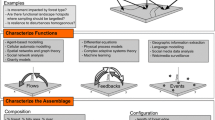Abstract
We echo viewpoints presented in recent publications from EcoHealth and other journals arguing for the need to understand linkages between human health, disease ecology, and landscape change. We underscore the importance of incorporating spatialities of human behaviors and perceptions in such analyses to further understandings of socio–ecological interactions mediating human health. We use Buruli ulcer, an emerging necrotizing skin infection and serious health concern in central Ghana, to illustrate our argument.
Similar content being viewed by others
References
Aagaard-Hansen J, Nombela N, Alvar J (2010) Population movement: a key factor in the epidemiology of neglected tropical diseases. Tropical Medicine & International Health 15:1281–1288. doi:10.1111/j.1365-3156.2010.02629.x)
Aiga H, Amano T, Cairncross S, Domako JA, Nanas O, Coleman S (2004) Assessing water-related risk factors for Buruli ulcer: a case-control study in Ghana. The American Journal of Tropical Medicine and Hygiene 71(4):387–92
Allan BF, Keesing F, Ostfeld RS (2003) Effect of forest fragmentation on lyme disease risk. Conservation Biology 17(1):267–272
Barbieri AF, Sawyer DO, Soares-Filho B (2005) Population and land use effects on malaria prevalence in the southern Brazilian Amazon. Human Ecology: An Interdisciplinary Journal 33:847–874. doi: 10.1007/s10745-005-8213-8)
Brace C, Geoghegan H (2011) Human geographies of climate change: landscape, temporality, and lay knowledges. Progress in Human Geography 35(3):284–302
Brooker S (2007) Spatial epidemiology of human schistosomiasis in Africa: risk models, transmission dynamics and control. Transactions of the Royal Society of Tropical Medicine and Hygiene 101:1–8
Brou T, Broutin H, Elguero E, Asse H, Guegan JF (2008) Landscape diversity related to Buruli ulcer disease in Cote d’Ivoire. PLoS Neglected Tropical Diseases 2(7):e271. doi:10.1371/journal.pntd.0000271)
Chevalier V, Dupressoir A, Tran A, Diop OM, Gottland C, Diallo M, Etter E, Ndiaye M, Grosbois V, Dia M, Gaidet-Drapier N, Sall AA, Soti V, Niang M (2010) Environmental risk factors of West Nile infection in the Senegal River basin. Epidemiology & Infection 138:1601–1609
Chua, KB, Bellini WJ, Rota PA, Harcourt BH, Tamin A, Lam SK, Ksiazek TG, Rollin PE, Zaki SR, Shieh WJ, Goldsmith CS, Gubler DJ, Roehrig JT, Eaton B, Gould AR, Olson J, Field H, Daniels P, Ling AE, Peters CJ, Anderson LJ, Mahy BWJ (2000) Nipah Virus: a recently emergent deadly paramyxovirus. Science 288(5470):1432–1435. doi:10.1126/science.288.5470.1432)
Chua KB, Koh CL, Hooi PS, Wee KF, Khong JH, Chua BH, Chan YP, Lim ME, Lam SK (2002) Isolation of Nipah virus from Malaysian Island flying-foxes. Microbes and Infection 4(2):145–151
Connell D (2010) Sustainable livelihoods and ecosystem health: exploring methodological relations as a source of synergy. EcoHealth 7: 351–360
Cumming GS (2010) Risk mapping for avian influenza: a social–ecological problem. Ecology and Society 15:32
Daniel M, Kolar J, Zeman P, Pavelka K, Sadlo J (1998) Predictive map of Ixodes ricinus high-incidence habitats and a tick-borne encephalitis risk assessment using satellite data. Experimental & Applied Acarology 22: 417–433
Daszak P, Cunningham AA (2000) Emerging infectious diseases of wildlife—threats to biodiversity and human health. Science 287:443
Debacker M, Portaels F, Aguiar J, Steunou C, Zinsou C, Meyers W, Dramaix M (2006) Risk factors for Buruli ulcer, Benin. Emerging Infectious Diseases 12(9):1325–31
Despommier D, Ellis B, Wilcox BA (2007) The role of ecotones in emerging infectious diseases. EcoHealth 3:281–289. doi:10.1007/s10393-006-0063-3)
Duker AA, Carranza EJM, Hale M (2004) Spatial dependency of Buruli ulcer prevalence on arsenic-enriched domains in Amansie West District, Ghana: implications for arsenic mediation in Mycobacterium ulcerans infection. International Journal of Health Geographics 3:19
Graham AJ, Danson FM, Giraudoux P, Craig PS (2004) Ecological epidemiology: landscape metrics and human alveolar echinococossis. Acta Tropica 91:267–278
Hayman J (1991) Postulated epidemiology of Mycobacterium ulcerans infection. International Journal of Epidemiology 20:1093–8
Horobik V, Keesing F, Ostfeld RS (2006) Abundance and Borrelia burgdorferi-infection prevalence of nymphal Ixodes scapularis ticks along forest–field edges. EcoHealth 3(4):262–268
Horsburgh CR Jr., Meyers WM (1997) Buruli ulcer. In: Pathology of Emerging Infections, Horsburgh CR Jr., Nelson AM (editors), Washington, DC: American Society for Microbiology, pp 119–126
Jacobsen K, Padgett J (2010) Risk factors for Mycobacterium ulcerans infection. International Journal of Infectious Diseases 14:e677–e681
Johnson RC, Sopoh GE, Boko M, Zinsou C, Gbovi J, Makoutode M, Portaels F (2005) Distribution of Mycobacterium ulcerans (Buruli ulcer) in the district of Lalo in Benin. Tropical Medicine and International Health 10(9):863–871
Jones KE, Patel NG, Levy MA, Storeygard A, Balk D, Gittleman JL, Daszak P (2008) Global trends in emerging infectious diseases. Nature 451:990–993
Kantso B, Svendsen CB, Jensen PM, Vennestrom J, Krogfelt KA (2010) Seasonal and habitat variation in the prevalence of Rickettsia helvetica in Ixodes ricinus ticks from Denmark. Ticks and Tick-borne Diseases 1:101–103
Kearns R, Moon G (2002) From medical to health geography: novelty, place and theory after a decade of change. Progress in Human Geography 26:605–25
Keesing F, Belden LK, Daszak P, Dobson A, Harvell CD, Holt RD, Hudson P, Jolles A, Jones KE, Mitchell CE, Myers SS, Bogich T, Ostfeld RS (2010) Impacts of biodiversity on the emergence and transmission of infectious diseases. Nature 468:647–652. doi:10.1038/nature09575)
King B (2010) Political ecologies of health. Progress in Human Geography 34(1):38–55
Kloos H, Gazzinelli A, Van Zuyle P (1998) Microgeographical patterns of schistosomiasis and water contact behavior; examples from Africa and Brazil. Memórias do Instituto Oswaldo Cruz 93:37–50
Lambin EF, Tran A, Vanwambeke SO, Linard C, Soti V (2010) Pathogenic landscapes: interactions between land, people, disease vectors, and their animal hosts. International Journal of Health Geographics 9(54):1–13
Linard C, Tersago K, Leirs H, Lambin EF (2007) Environmental conditions and Puumala virus transmission in Belgium. International Journal of Health Geographics 6:55
Liu J, Dietz T, Carpenter SR, Alberti M, Folke C, Moran E, Pell AN, Deadman P, Kratz T, Lubchenco J, Ostrom E, Ouyang Z, Provencher W, Redman CL, Schneider SH, Taylor WW (2007) Coupled human and natural systems. Ambio 36(8):639–49
Meade M (1976) Land development and human health in West Malaysia. Annals of the Association of American Geographers 66:428–439
Meliker JR, Sloan CD (2011) Spatio-temporal epidemiology: principles and opportunities. Spatial and Spatio-temporal Epidemiology 2:1–9. doi:10.1016/j.sste.2010.10.001)
Merritt RW, Benbow ME, Small PLC (2005) Unraveling an emerging disease associated with disturbed aquatic environments: the case of Buruli ulcer. Frontiers in Ecology and the Environment 3:323–331
Merritt RW, Walker ED, Small PLC, Wallace JR, Johnson PDR, Benbow ME, Boakye DA (2010) Ecology and transmission of Buruli ulcer disease: a systematic review. PLOS Neglected Tropical Diseases 4(12):1–15
Norris D (2004) Mosquito-borne diseases as a consequence of land use change. EcoHealth 1:1924
Ostfeld RS, Glass GE, Keesing F (2005) Spatial epidemiology: an emerging (or re-emerging) discipline. Trends in Ecology & Evolution 20:328–336. doi:10.1016/j.tree.2005.03.009)
Ostfeld RS (2010) Lyme Disease: The Ecology of a Complex System, New York: Oxford University Press
Patz JA, Graczyk TK, Geller N, Vittor AY (2000) Effects of environmental change on emerging parasitic diseases. International Journal of Parasitology 30:1395–405
Patz JA, Daszak P, Tabor GM, Aguirre AA, Pearl M, Epstein J, Wolfe ND, Kilpatrick AM, Foufopoulos J, Molyneux D, Bradley DJ, Members of the Working Group on Land Use Change Disease Emergence (2004) Unhealthy landscapes: policy recommendations on land use change and infectious disease emergence. Environmental Health Perspectives 112:1092–1098
Pijanowski BC, Iverson LR, Drew CA, Bulley HNN, Rhemtulla JM, Wimberly MC, Bartsch A, Peng J (2010) Addressing the interplay of poverty and the ecology of landscapes: a grand challenge topic for landscape ecologists? Landscape Ecology 25:5–16
Pulliam JRC, Epstein JH, Dushoff J, Rahman SA, Bunning M, Jamaluddin AA, Hyatt AD, Field HE, Dobson AP, Daszak P (2011) Agricultural intensification, priming for persistence and the emergence of Nipah virus: a lethal bat-borne zoonosis. Journal of the Royal Society Interface 9(66):89–101
Radford AJ (1975) Mycobacterium ulcerans infection in Papua New Guinea. Papua New Guinea Medical Journal 17:145–149
Raffy M, Tran A (2005) On the dynamics of flying insects populations controlled by large scale information. Theoretical Population Biology 68:91–104
Raghunathan PL, Whitney EA, Asamoa K, Stienstra Y, Taylor TH, Amofa GK, Ofori-Adjei D, Dobos K, Guarner J, Martin S, Pathak S, Klutse E, Etuaful S, van der Graff WT, van der Werf TS, King CH, Tappero JW, Ashford DA (2005). Risk factors for Buruli ulcer disease (Mycobacterium ulcerans infection): results from a case-control study in Ghana. Clinical Infectious Diseases 40(10):1445–53
Rainham D, McDowell I, Krewski D, Sawada M (2010) Conceptualizing the healthscape: contributions of time geography, location technologies and spatial ecology to place and health research. Social Science & Medicine 70:668–676. doi:10.1016/j.socscimed.2009.10.035)
Seto EYW, Knapp F, Zhong B, Yang C (2007) The use of a vest equipped with a global positioning system to assess water-contact patterns associated with schistosomiasis. Geospatial Health 1:233–241
Smucker TA, Campbell DJ, Olson JM, Wangui EE (2007) Contemporary challenges of participatory field research for land use change analyses: examples from Kenya. Field Methods 19(4):384–406
Stoddard ST, Morrison AC, Vazquez-Prokopec G, Soldan VP, Kochel TJ, Kitron U, Elder JP, Scott TW (2009) The role of human movement in the transmission of vector-borne pathogens. PLoS Neglected Tropical Diseases 3:1–9. doi:10.1371/journal.pntd.0000481)
Stothard JR, Sousa-Figueiredo J, Betson M, Seto EYW, Kabatereine NB (2011) Investigating the spatial micro-epidemiology of diseases within a point-prevalence sample: a field applicable method for rapid mapping of households using low-cost GPS-dataloggers. Transactions of the Royal Society of Tropical Medicine and Hygiene 105:500–506
Thangaraj HS, Evans MR. (1999) Mycobacterium ulcerans disease; Buruli ulcer. Transactions of the Royal Society of Tropical Medicine and Hygiene 93(4):337–40
Vanwambeke SO, Lambin EF, Eichhorn MP, Flasse SP, Harback RE, Oskam L, Somboon, P, van Beers S, van Benthem BHB, Walton C, Butlin RK (2007) Impact of land-use change on dengue and malaria in northern Thailand. EcoHealth 4:37–51. doi:10.1007/s10393-007-0085)
Vazquez-Prokopec G, Stoddard ST, Paz-Soldan V, Morrison AC, Elder JP, Kochel TJ, et al. (2009) Usefulness of commercially available GPS data-loggers for tracking human movement and exposure to dengue virus. International Journal of Health Geographics 8:68
Wang YC, Feng CC, Sithithaworn P, Feng W, Petney TN (2011) How do snails meet fish? Landscape perspective needed to study parasite prevalence. EcoHealth 8: 258–260
Wagner T, Benbow M, Brenden T, Jiaguo, Johnson RC (2008a) Buruli ulcer disease prevalence in Benin, West Africa: associations with land use/cover and the identification of disease clusters. International Journal of Health Geographics 7:25
Wagner T, Benbow ME, Burns M, Johnson RC, Merritt RW, Qi J, Small, PLC (2008b) A landscape-based model for predicting Mycobacterium ulcerans infection (Buruli Ulcer disease) presence in Benin, West Africa. EcoHealth 5(1):69–79
Wilcox BA, Colwell RR (2005) Emerging and reemerging infectious diseases: biocomplexity as an interdisciplinary paradigm. EcoHealth 2:244–257. doi:10.1007/s10393-005-8961-3)
Williamson HR, Benbow ME, Campbell LP, Johnson CR, Sopoh G, Barogui Y, Merritt RW, Small PLC (2012) Detection of Mycobacterium ulcerans in the environment predicts prevalence of Buruli ulcer in Benin. PLoS Neglected Tropical Diseases 6:1–9. doi:10.1371/journal.pntd.0001506)
World Health Organization (2007) Buruli Ulcer Disease (Mycobacterium ulcerans Infection), Geneva: Fact Sheet No. 199
Acknowledgments
We would like to acknowledge our project team members: Charles Abbey, Bernadette Atosona, David Azanu, Leah Bug, Nathan Clay, Emmanuel Effah, Simon Gawu, Yakubu Iddrisu Goro, Saviour Mantey, Frank Nyame, Grace Ofori-Sarpong, Joseph Oppong, Edith Parker, Warangkana Ruckthongsook, Kamini Singha, Rose Sandow, Ray Voegborlo, Annemarie Ward. We are also grateful for the insight of the two anonymous reviewers.
Author information
Authors and Affiliations
Corresponding author
Rights and permissions
About this article
Cite this article
Hausermann, H., Tschakert, P., Smithwick, E.A.H. et al. Contours of Risk: Spatializing Human Behaviors to Understand Disease Dynamics in Changing Landscapes. EcoHealth 9, 251–255 (2012). https://doi.org/10.1007/s10393-012-0780-8
Received:
Revised:
Accepted:
Published:
Issue Date:
DOI: https://doi.org/10.1007/s10393-012-0780-8




